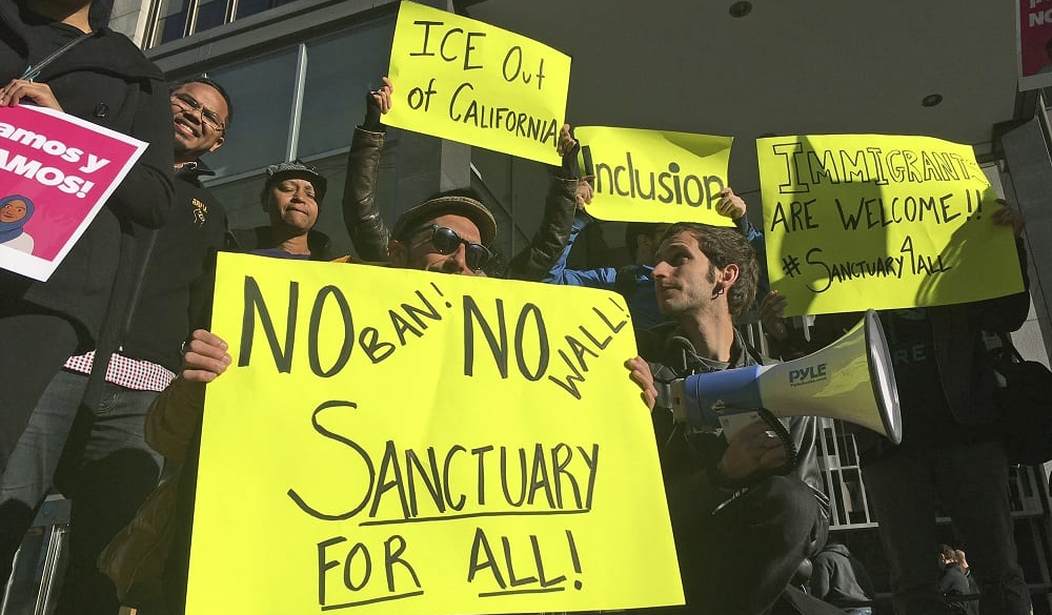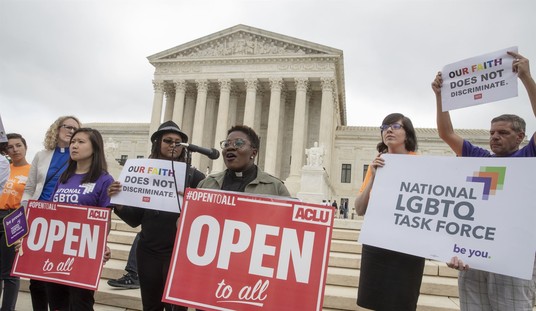
Protesters hold up signs outside a courthouse where a federal judge will hear arguments in the first lawsuit challenging President Donald Trump’s executive order to withhold funding from communities that limit cooperation with immigration authorities Friday, April 14, 2017, in San Francisco. U.S. District Court Judge William Orrick has scheduled a hearing on Friday on San Francisco’s request for a court order blocking the Trump administration from cutting off funds to any of the nation’s so-called sanctuary cities. (AP Photo/Haven Daley)
US immigration law is the focus of a sustained attack by leftwing groups who see the ongoing invasion by illegal immigrants as a sure ticket to political power and by their allies on the bench. Perhaps nowhere are those allies stronger and more deeply entrenched than they are in the Ninth Circuit. The Ninth Circuit’s revolt against the ability of Congress to make laws that conflict with the superior judgment of judges on the court is pretty well documented. In fact, one of the deceased heroes of the Ninth, Stephen Reinhardt, was very open about what he and his colleagues were doing. He said they ruled as they wished and didn’t care if they were frequently reversed because the Supreme Court only takes a handful of cases and “They can’t catch ‘em all.”
Often, the Ninth Circuit, to get the result it wants, ties a law to the rack and tortures it until it changes its meaning. And sometimes, when it becomes one of the ones the Supreme Court does catch, we are able to see the scope of the attack. The case the Supreme Court decided today, Nielsen vs. Preap, was one of those rare wins for common sense.
This is a class-action case on behalf of immigrants, many of whom served or are serving sentences, or even probation, for minor offenses. One of the lead plaintiffs, Mony Preap, was born to Cambodian parents in a refugee camp; he has lived lawfully in the U.S. since 1981. In 2006, he was convicted on two misdemeanor counts of possessing marijuana—an offense that would have subjected him to mandatory detention. However, immigration authorities did not arrest him then. Instead, he returned to his community and was convicted of battery—which does not trigger the mandatory-detention statute. Immigration and Customs Enforcement at that point took him to a detention center, and he was denied a bond hearing. He was eventually able to show an immigration judge that he was eligible for “cancellation,” and so he has been released.
Another plaintiff, Eduardo Vega Padilla, arrived as a toddler and has been a lawful resident for 52 years; his six grandchildren are all U.S. citizens. He was convicted of controlled-substance offenses in 1997 and 1999, and placed on probation; while he was serving that sentence, he was convicted of possessing an unloaded pistol, then released in 2002. In 2013, ice agents arrested him at his home. Because of the drug offense, ice denied him a bond hearing until a district court ordered them to provide one—at which point he won release.
Representing all immigrants arrested under similar circumstances, the plaintiffs argue that if ice wants to detain an immigrant without hope of bail, it must detain him or her at the moment of release; any other reading of the when in the statute, they say, allows authorities to wait years, and then detain immigrants long after they have successfully returned to their lives. Congress cannot have intended that.
The Ninth Circuit ruled that if the criminal alien was not taken into ICE custody immediately upon conviction, that they were prohibited from ever taking the illegal into custody.
Today, in a 5-4 decision, the Supreme Court majority upheld the text of the law against the four liberal justices who would have created a situation where it would be nearly impossible for ICE to detain criminal aliens in large parts of the United States. The Supreme Court was well aware of this because, in addition to addressing the text of the law and how it is applied, they noted that the refusal of so-called sanctuary jurisdictions to cooperate with ICE would make the law impossible to enforce:
Especially hard to swallow is respondents’ insistence that for an alien to be subject to mandatory detention under §1226(c), the alien must be arrested on the day he walks out of jail (though respondents allow that it need not be at the jailhouse door—the “parking lot” or “bus stop” would do). Tr. of Oral Arg. 44. “Assessing the situation in realistic and practical terms, it is inevitable that” respondents’ unsparing deadline will often be missed for reasons beyond the Federal Government’s control. Montalvo-Murillo, 495 U. S., at 720. Cf. Regions Hospital v. Shalala, 522 U. S. 448, 459, n. 3 (1998) (“The Secretary’s failure to meet the deadline, a not uncommon occurrence when heavy loads are thrust on administrators, does not mean that [she] lacked power to act beyond it”). To give just one example, state and local officials sometimes rebuff the Government’s request that they give notice when a criminal alien will be released. Indeed, over a span of less than three years (from January 2014 to September 2016), the Government recorded “a total of 21,205 declined [requests] in 567 counties in 48 states including the District of Columbia.” ICE, Fiscal Year 2016 ICE Enf. and Removal Operations Rep. 9. Nor was such local resistance unheard of when Congress enacted the language of §1226(c) in 1996. See S. Rep. No. 104–48, p. 28 (1995). Under these circumstances, it is hard to believe that Congress made the Secretary’s mandatory-detention authority vanish at the stroke of midnight after an alien’s release. In short, the import of our case law is clear: Even if subsection (c) were the only font of authority to detain aliens without bond hearings, we could not read its “when . . . released” clause to defeat officials’ duty to impose such mandatory detention when it comes to aliens who are arrested well after their release.
The impact of the government winning this case can’t be overstated. The Ninth Circuit was in conflict with four other circuit courts. Had this decision been affirmed, it would have imposed this rule on the rest of the nation. This was not only a win for the nation but a win for the rule of law and for the English language itself.
=========
=========
Like what you see? Then visit my story archive.
Follow @streiffredstate
I’m on Facebook. Drop by and join the fun there.
=========
=========













Join the conversation as a VIP Member